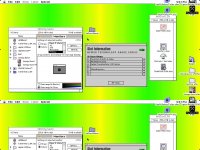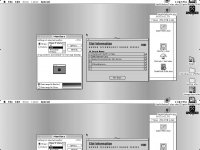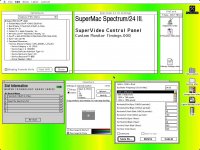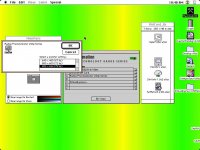Trash80toHP_Mini
NIGHT STALKER
. . . or at least swapping its DeclarationROM out for a better one?
TylerEss approached me about this in PM and it turned out to be very interesting indeed! Way to go comrade! :approve:
So this isn't my hack, I just happen to have the necessary toys on hand to test out his theory.
Tyler has a 15" LCD with a native resolution of 1024 x 768 and the MaxRes of the Radius PrecisionColor 24XP is Mac 16" and not the 19" he'd like to achieve. If it turns out to be at a lower bit count, it doesn't matter to him, he just wants native resolution/more screen acreage.
He wondered if Radius lobotomized his 24XP at the DeclROM level to keep the "Personal" version of the Pro X Series down to that market segment by more than its VRAM allotment.
His thinking is that:
_If_ the RCP 24XP has enough VRAM to achieve 24bit Color at 832 x 624 . . .
_then_ it should have the VRAM to push out 16bit Color at 1024 x 768 . . .
_therefore_the Card must be limited in some other way to hold its MaxRes to the lower pixelcount.
Which led him to suspect that Radius hobbled the 24XP at the Declaration ROM level.
He'd read about my ROM swapping somewhere, probably this thread: Is it is . . . or is it ain't . . . IT IS!!!! =8-D
Whatever . . . his question jogged my memory about having that 24XP in the Magic Plastic Shoe Box of NuBus VidCard Goodness. The 24X ROM was still sitting in the socket of an Apple 24AC right there in my Pet IIfx . . . so I swapped the ROM out and did some tests . . .
. . . and wound up getting back to work 5 minutes late from lunch.
I could swear that I got the 24XP to do 1024 x 768 @ 24bit successfully the first try, but I didn't do a screen shot, so I can't be sure. I know when I tried it at 1152 x 870, the Card wigged out in a very interesting and consistent manner. Later testing Appears to show that it was really displaying 16bit pixels, despite the Monitors Control Panel showing it as 24bit.
edit: I was probably so surprised to see 1024 x 768 pixels pop up on the screen in B&W that I misremembered it as having been successfully changed to 24bit.
Whatever . . . 1024 x 768 test results:
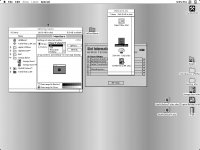
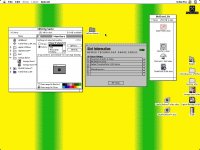
1152 x 870 test results:
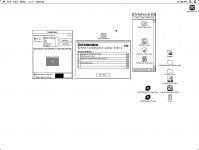


So far, so good, but it gets very strange! 8-o
edit: Tyler, I know this isn't the result you were hoping for (as yet! [} ] ]'> ) but it's very promising!
] ]'> ) but it's very promising!
personal note: I wish I'd had 4bits of grayscale on my first big CRT. The Panasonic M1900 output the equivalent of the 1152 x 870 x 1bit B&W pic above on a 19" CRT. There was a card available that would do a much nicer grayscale image, probably better than the one above, but I couldn't afford it. Still, after doing graphic design in a kiddie pool through the 9" B&W periscope on my SE/Radius_16, it was like doing a back float in an Olympic size swimming pool with that Panasonic Card/CRT combo and the (used) Mac IIx! [ ] ]'>
] ]'>
TylerEss approached me about this in PM and it turned out to be very interesting indeed! Way to go comrade! :approve:
So this isn't my hack, I just happen to have the necessary toys on hand to test out his theory.
Tyler has a 15" LCD with a native resolution of 1024 x 768 and the MaxRes of the Radius PrecisionColor 24XP is Mac 16" and not the 19" he'd like to achieve. If it turns out to be at a lower bit count, it doesn't matter to him, he just wants native resolution/more screen acreage.
He wondered if Radius lobotomized his 24XP at the DeclROM level to keep the "Personal" version of the Pro X Series down to that market segment by more than its VRAM allotment.
His thinking is that:
_If_ the RCP 24XP has enough VRAM to achieve 24bit Color at 832 x 624 . . .
_then_ it should have the VRAM to push out 16bit Color at 1024 x 768 . . .
_therefore_the Card must be limited in some other way to hold its MaxRes to the lower pixelcount.
Which led him to suspect that Radius hobbled the 24XP at the Declaration ROM level.
He'd read about my ROM swapping somewhere, probably this thread: Is it is . . . or is it ain't . . . IT IS!!!! =8-D
Whatever . . . his question jogged my memory about having that 24XP in the Magic Plastic Shoe Box of NuBus VidCard Goodness. The 24X ROM was still sitting in the socket of an Apple 24AC right there in my Pet IIfx . . . so I swapped the ROM out and did some tests . . .
. . . and wound up getting back to work 5 minutes late from lunch.
I could swear that I got the 24XP to do 1024 x 768 @ 24bit successfully the first try, but I didn't do a screen shot, so I can't be sure. I know when I tried it at 1152 x 870, the Card wigged out in a very interesting and consistent manner. Later testing Appears to show that it was really displaying 16bit pixels, despite the Monitors Control Panel showing it as 24bit.
edit: I was probably so surprised to see 1024 x 768 pixels pop up on the screen in B&W that I misremembered it as having been successfully changed to 24bit.
Whatever . . . 1024 x 768 test results:


1152 x 870 test results:



So far, so good, but it gets very strange! 8-o
edit: Tyler, I know this isn't the result you were hoping for (as yet! [}
personal note: I wish I'd had 4bits of grayscale on my first big CRT. The Panasonic M1900 output the equivalent of the 1152 x 870 x 1bit B&W pic above on a 19" CRT. There was a card available that would do a much nicer grayscale image, probably better than the one above, but I couldn't afford it. Still, after doing graphic design in a kiddie pool through the 9" B&W periscope on my SE/Radius_16, it was like doing a back float in an Olympic size swimming pool with that Panasonic Card/CRT combo and the (used) Mac IIx! [



